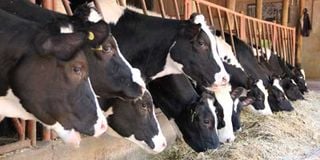Zero grazing best way to go for small farms

Zero grazing: Dairy cows at a shed at Lewa Children’s Home in Eldoret. Some dairy farmers prepare their own animal feed to ensure a steady supply. PHOTO | JARED NYATAYA
What you need to know:
- With good planning, many dairy animals can be kept on a relatively small piece of land
- In zero grazing, individual attention in terms of feeding is possible as the animal does not spent energy searching for food
Zero grazing as a system of commercial dairy production has many advantages compared to free grazing. In the zero grazing system, dairy animals are confined within a structure from where they are fed, milked and spend the night.
With good planning, many dairy animals can be kept on a relatively small piece of land, making this system suitable in areas where a farmer owns a small piece of land.
In zero grazing, individual attention in terms of feeding is possible as the animal does not spent energy searching for food. Zero grazing also makes disease and vector control easy.
A good zero grazing unit design should take into consideration the following:
(i) Safety. A good dairy animal is a costly investment that must be accorded security. This can be ensured by the kind of design you adopt for the unit and its location.
In my practice, I have come across many cases of malicious poisoning of pedigree high producing dairy cows and vandalism by jealous neighbours or even farm workers.
Locating the unit close to farm houses will add to security, but this should be such that the wind should blow away the dung smell.
(ii) Good dung handling design. Dung is a daily by-product from dairy production and measures must be incorporated in the unit design to ensure that it is properly disposed of without being an odour nuisance to the farm and neighbourhood.
(iii) Ventilation. Good ventilation is good for a healthy respiratory system and adds to the comfort, which we have noted is crucial for maximal milk production.
The level of ventilation depends on the climatic conditions of a given area. Where the climate is hot, a zero grazing unit should be scantily enclosed to maximise air circulation and reduce heat stress. The direction of the wind is important in ensuring good ventilation while at the same time protecting the animal from adverse climatic conditions.
(iv) Protection from adverse weather conditions like rain, strong wind and hot sunshine. Where winds are strong consider utilising wind breakers like trees and buildings.
(v) Isolation is a key function of a zero-grazing unit. Different animals need to be isolated from each other to avoid injuries resulting from fights and mounting to control breeding and avoid spread of diseases.
Comfort this is the sum total of all the above considerations and the components of the unit. Nonetheless, it must be noted that confinement in zero-grazing can result in stress.
In general, a zero grazing unit will basically have the following sections: cubicles, walking area, watering and feeding troughs, a milking place and cow dung handling areas, a store, calf pen. A water tank and fodder cutting sections are also important if resources can allow.
Cubicles in a dairy unit form the resting area (sitting room) for the cow, thus it should not restrain the animal from moving around. Six feet by 3ft to 7ft by 4 ft is the recommended measurements depending on the animal size. Cubicles are normally covered with soft materials like saw dust to avoid wounds from bruises as the animal sleeps. Mineral supplement links should be suspended here.
The walking area, which lies between the cubicles and feeding and watering areas, is normally open except where the climatic conditions are extremely hot. It is recommended that the floor should be made of concrete for ease of cleaning and should have a gradual slope towards the dung pit and be about 3ft wide.
Feed and water troughs should be raised above the ground to avoid contamination from the walking area and to ensure easy feeding by the cow. Water should always be available and must have an outlet to drain before refilling.
Particular consideration must be given to the milking area to ensure clean milk production. This should be placed side by side with the cubicles but away from the dung pit as milk has the ability to pick odours from the environment. It must have feeding troughs as milk let down is normally favoured by dairy meal during milking.
Dr. Othieno teaches Agricultural Information and Communication Management at the University of Nairobi




